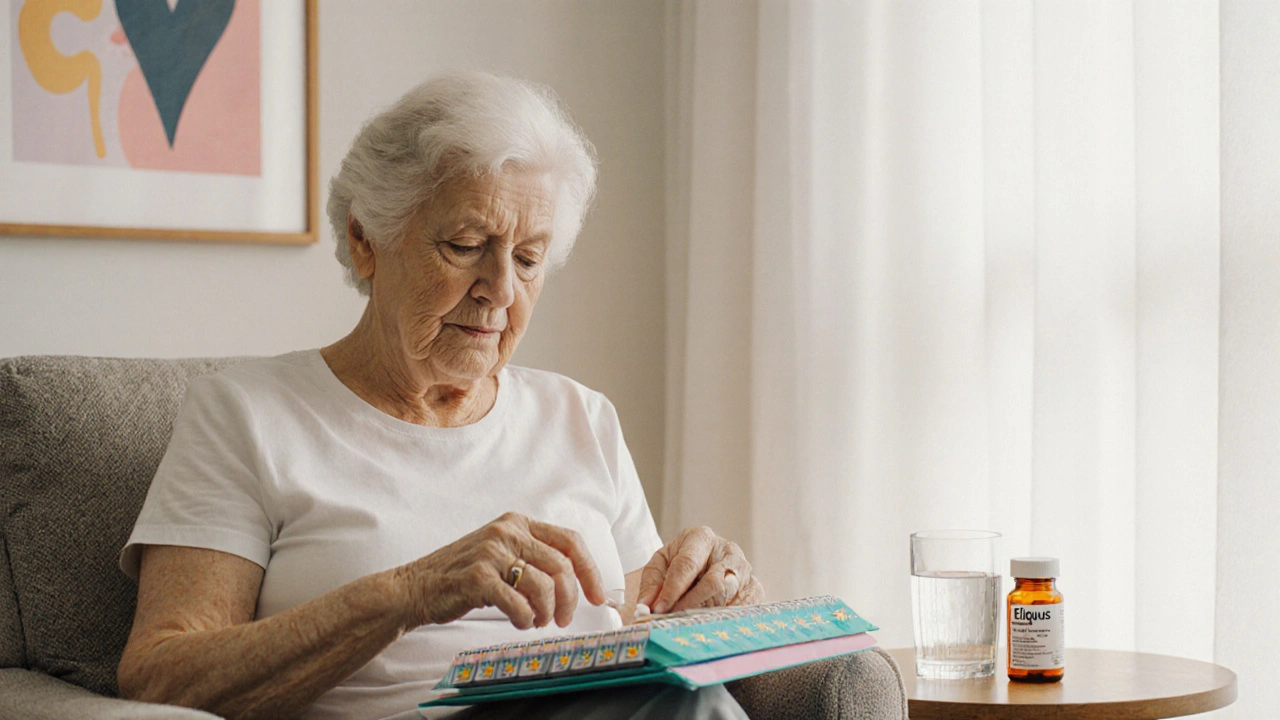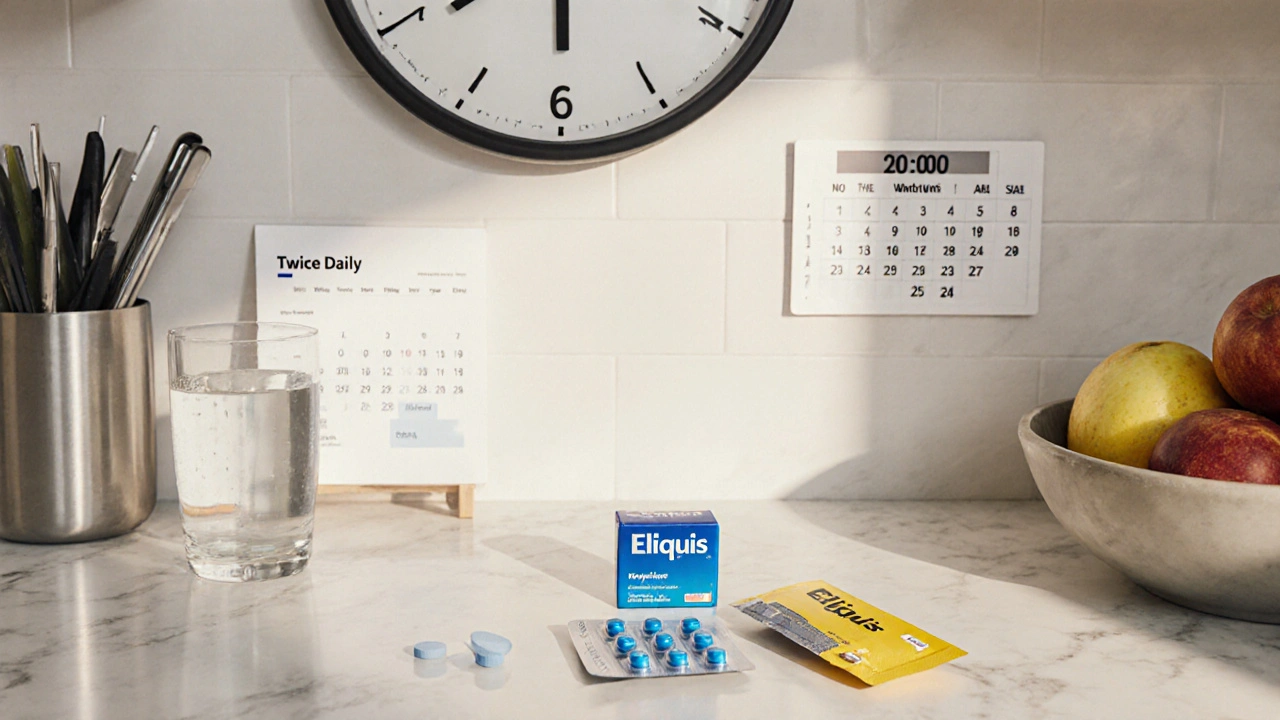Anticoagulant Comparison Tool
This tool helps compare Eliquis with other anticoagulants based on your specific needs and medical profile. Select your kidney function level and priority to get personalized recommendations.
- Eliquis offers twice-daily dosing with no routine monitoring
- Warfarin is the cheapest but requires regular INR checks
- Xarelto provides once-daily dosing but has strict kidney limits
- Pradaxa has a specific reversal agent and may cause GI upset
- Savaysa sits between Eliquis and Xarelto on cost and bleeding risk
Quick Summary / Key Takeaways
- Eliquis (apixaban) offers twice‑daily dosing with no routine blood monitoring, making it convenient for many patients.
- Warfarin remains the cheapest option but requires frequent INR checks and has many food‑drug interactions.
- Xarelto (rivaroxaban) provides once‑daily dosing but has stricter kidney‑function limits compared to Eliquis.
- Pradaxa (dabigatran) has a specific reversal agent (idarucizumab) and may cause dyspepsia in some users.
- Savaysa (edoxaban) sits between Eliquis and Xarelto on cost and bleeding risk, with a once‑daily schedule.
What is Eliquis (Apixaban)?
Eliquis is a direct oral anticoagulant (DOAC) that inhibits factorXa, preventing blood clots from forming. It was approved by the FDA in 2012 for stroke prevention in atrial fibrillation (AFib) and treatment of deep‑vein thrombosis (DVT) and pulmonary embolism (PE). The standard dose is 5mg taken twice daily, with a reduced dose (2.5mg) for patients meeting specific age, weight, or kidney‑function criteria.
Why Compare Eliquis with Other Anticoagulants?
Choosing the right blood thinner isn’t just about price; it’s about how the drug fits your lifestyle, health status, and insurance coverage. Patients often ask: which option has the lowest bleed risk? Which works best for AFib? How often will I need lab tests? This guide breaks down the most common alternatives to help you answer those questions.
Key Alternatives to Eliquis
Below are the main competitors you’ll encounter when discussing anticoagulation with a doctor.
Warfarin is a vitaminK antagonist that has been used for decades. It works by reducing the synthesis of clotting factors II, VII, IX, and X. Dosing is individualized based on regular INR (International Normalized Ratio) testing, aiming for a target range of 2.0-3.0 for most indications.
Xarelto (rivaroxaban) is another factorXa inhibitor, but it is taken once daily for most indications. It received FDA approval in 2011 and is available in 10mg and 20mg tablets, with dose adjustments for renal impairment.
Pradaxa (dabigatran) is a direct thrombin (factorIIa) inhibitor. It comes in 150mg and 75mg capsules, usually taken twice daily. A specific reversal agent, idarucizumab, allows rapid clotting factor restoration if severe bleeding occurs.
Savaysa (edoxaban) is a factorXa inhibitor approved in 2015. The usual dose is 60mg once daily, reduced to 30mg for patients with low body weight or impaired kidney function.
Atrial Fibrillation is an irregular heart rhythm that increases the risk of stroke. Anticoagulants like Eliquis are prescribed to reduce that risk.
Deep Vein Thrombosis (DVT) and Pulmonary Embolism (PE) are clot‑related conditions often treated with the same anticoagulant options.
Side‑by‑Side Comparison Table
| Drug | Mechanism | Dosing Frequency | Monitoring Needed? | Reversal Agent | Approx. Monthly Cost (US$) | Key Pros | Key Cons |
|---|---|---|---|---|---|---|---|
| Eliquis (Apixaban) | FactorXa inhibitor | Twice daily | No routine labs | Andexanet alfa (limited availability) | ≈$320 | Low bleed risk, no INR checks | Twice‑daily dosing, higher cost |
| Warfarin | VitaminK antagonist | Once daily | Frequent INR tests | VitaminK, fresh frozen plasma | ≈$15 | Very cheap, reversible with vitaminK | Dietary restrictions, lab visits |
| Xarelto (Rivaroxaban) | FactorXa inhibitor | Once daily (20mg) or twice daily (10mg) | No routine labs | Andexanet alfa (off‑label) | ≈$340 | Convenient once‑daily dosing | Higher bleed risk in renal impairment |
| Pradaxa (Dabigatran) | Direct thrombin inhibitor | Twice daily | No routine labs | Idarucizumab (specific) | ≈$310 | Specific reversal agent, effective | Gastro‑intestinal upset common |
| Savaysa (Edoxaban) | FactorXa inhibitor | Once daily | No routine labs | Andexanet alfa (limited) | ≈$300 | Once‑daily dosing, modest cost | Not approved for mechanical heart valves |
How to Choose the Right Anticoagulant for You
Think of picking a blood thinner like choosing a car. You weigh price, fuel efficiency, maintenance schedule, and how it handles different road conditions. Here’s a quick decision framework:
- Kidney function matters. If your eGFR is below 30mL/min, warfarin or a dose‑reduced Eliquis may be safer than Xarelto.
- Do you mind blood tests? Warfarin needs INR checks; all DOACs (Eliquis, Xarelto, Pradaxa, Savaysa) do not.
- Cost vs convenience. If you have generous insurance, the higher cost of DOACs is often offset. Without coverage, warfarin is hard to beat on price.
- Bleeding risk profile. Studies up to 2024 show Eliquis has the lowest major‑bleed rates among DOACs, especially in older adults.
- Reversal needs. If you anticipate surgery or have a high fall risk, Pradaxa’s dedicated antidote (idarucizumab) may give peace of mind.
Discuss these points with your clinician. They’ll weigh your medical history, other meds, and lifestyle before recommending a specific agent.
Real‑World Scenarios
Scenario 1 - Active senior on multiple meds: Mary, 78, has AFib, mild kidney disease, and takes a statin and antihypertensive. Her doctor chose Eliquis 2.5mg twice daily because it offers low bleed risk and doesn’t interact much with her other drugs.
Scenario 2 - Young athlete with a DVT: Jake, 32, recovered from a sports‑related leg injury that caused a clot. He prefers a once‑daily pill and has normal kidney function, so his physician prescribed Xarelto 20mg once daily.
Scenario 3 - Patient needing rapid reversal: Laura is scheduled for urgent orthopedic surgery. She’s on Pradaxa, and the surgeon knows idarucizumab can reverse its effect within minutes if needed.

Potential Pitfalls and How to Avoid Them
- Skipping dose. DOACs lose protection quickly; missing even one dose can raise clot risk. Set alarms or use pill organizers.
- Ignoring kidney updates. Renal function can decline with age. Annual eGFR checks ensure dosing stays safe.
- Undue reliance on over‑the‑counter NSAIDs. Combining NSAIDs with any anticoagulant spikes bleed risk. Discuss pain management alternatives with your doctor.
- Assuming all DOACs are interchangeable. While they share a class, their dosing schedules, food interactions, and reversal options differ.
Bottom Line: The Eliquis comparison in a nutshell
Eliquis stands out for its balanced efficacy‑safety profile, especially in older adults and those with modest kidney impairment. It’s pricier than warfarin but more convenient because there’s no INR monitoring. Xarelto wins on once‑daily dosing; Pradaxa offers a fast‑acting antidote; Savaysa provides a middle ground on cost and dosing. Your final choice will hinge on kidney health, cost considerations, need for reversal, and how much lab work you’re willing to tolerate.
Frequently Asked Questions
Can I switch from warfarin to Eliquis without a washout period?
Yes, most clinicians overlap the last warfarin dose with the first Eliquis dose when the INR falls below 2.0. This avoids a gap in anticoagulation while minimizing bleed risk.
Is there a generic version of Eliquis?
As of 2025, no FDA‑approved generic apixaban is on the market, though several manufacturers have filed abbreviated new drug applications that may launch later this year.
What should I do if I miss a dose of Eliquis?
Take the missed dose as soon as you remember unless it’s less than 8hours later; then skip it and continue with your regular schedule. Never double up.
How does kidney function affect dosing for Xarelto?
If eGFR is below 30mL/min, the recommended dose drops from 20mg to 15mg once daily, and some clinicians prefer switching to Eliquis or warfarin.
Does Pradaxa cause more stomach upset than other DOACs?
Clinical data show up to 20% of patients report dyspepsia, especially at the higher 150mg dose. Taking the medication with food often reduces this side effect.
Are there any dietary restrictions with Eliquis?
No. Unlike warfarin, Eliquis does not interact with vitaminK‑rich foods, so you can enjoy leafy greens without worrying about INR fluctuations.
Next Steps
If you’re considering a switch or starting a new anticoagulant, follow this checklist:
- Schedule a blood‑work appointment to confirm kidney function (eGFR) and liver enzymes.
- List all prescription, OTC, and supplement meds; bring the list to your provider.
- Ask your pharmacist about cost, insurance coverage, and any patient‑assistance programs.
- Set up a daily reminder on your phone or a pill‑box organized by day.
- Know the signs of serious bleeding (e.g., unexplained bruising, blood in urine or stool) and when to call emergency services.
Armed with this Eliquis comparison, you can have an informed conversation with your healthcare team and choose the anticoagulant that best fits your health needs and lifestyle.

Taryn Esses
October 10, 2025 AT 22:16
Interesting overview.
Matt Quirie
October 22, 2025 AT 12:02
The guide does a thorough job of outlining each anticoagulant, it presents the pharmacologic mechanisms clearly, and it juxtaposes cost against convenience in a way that is useful for patients; the inclusion of dosing frequency helps readers visualize daily pill burden. It also highlights the importance of renal function, which is a critical factor for drug selection; the table summarizing monthly costs is an excellent quick reference. Moreover, the discussion of reversal agents adds a safety dimension that many lay summaries omit; this is particularly pertinent for surgical planning. The narrative emphasizes that warfarin, while inexpensive, requires frequent INR monitoring, which can be a logistical challenge for some individuals; by contrast, DOACs eliminate that need, enhancing adherence. The section on real‑world scenarios personalizes the data, making it relatable. In addition, the checklist at the end serves as a practical action plan for patients considering a switch. The article could benefit from a deeper dive into drug–drug interactions, especially with common over‑the‑counter NSAIDs; this omission may leave some readers unaware of bleeding risk augmentation. Overall, the guide is balanced, evidence‑based, and user‑friendly, making it a valuable resource for both clinicians and patients alike.
Pat Davis
November 3, 2025 AT 01:49
This comparison correctly emphasizes the primacy of renal function when selecting an anticoagulant; clinicians must adjust dosing or switch agents based on eGFR trends. The data on major‑bleed rates aligns with recent meta‑analyses that place apixaban at the lower end of the spectrum. Additionally, the mention of specific reversal agents reflects current best practice, especially for urgent surgical contexts. While the cost discussion is useful, it could further address insurance formularies, as out‑of‑pocket expenses vary widely. Nonetheless, the guide provides a solid framework for individualized decision‑making.
Mary Wrobel
November 14, 2025 AT 15:36
Wow, this guide really breaks down the nitty‑gritty of blood thinners without drowning you in jargon. I love the "real‑world scenarios" part – it makes the otherwise dry data feel relatable. The side‑by‑side table is a killer tool for quick reference, especially when you’re scrolling through insurance portals. If you’re like me and hate daily labs, the convenience of DOACs shines through. Just remember to keep an eye on kidney labs annually; it’s a tiny price for peace of mind.
Lauren Ulm
November 26, 2025 AT 05:22
Reading this, I can’t help but wonder why the pharma giants keep pushing high‑priced DOACs while keeping cheaper warfarin under the radar. It feels like a coordinated effort to keep us dependent on pricey meds, especially when reversal agents are scarce and costly. 🤔 The fact that the guide mentions insurance assistance programs is good, but the system still funnels profit toward the drug manufacturers. Keep questioning the narratives they feed us.
Michael Mendelson
December 7, 2025 AT 19:09
Yo, you totally missed the point. Warfarin is like the old school classic, you know? It’s cheap, widely available, and you can actually monitor it, unlike those fancy DOACs that hide behind “no labs needed”. Plus, the reversal agents are just a marketing gimmick – they cost a fortune. If you’re smart, you’ll stick with warfarin and save some cash.